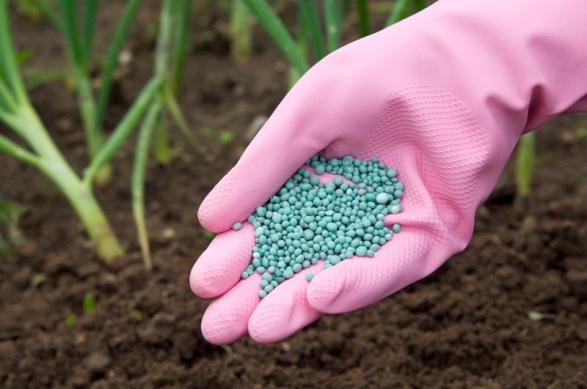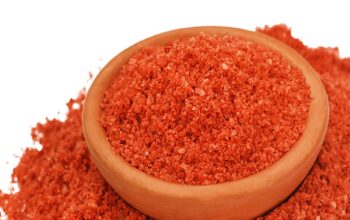Plants need nitrogen to grow, develop and produce usable products. Since plants get their nitrogen from the soil, farmers must replenish nitrogen to ensure successful growth and to replace nitrogen removed in the harvested crop. Nitrogen is generally applied to the soil through various types of fertilizers. Due to the substantial yield increases resulting from fertilization, farmers have steadily increased the amount of fertilizer added per unit of land area. When plants are not provided with sufficient nitrogen, they become nitrogen deficient. Plants with nitrogen deficiency often have spindly stems and their growth is stunted. Nitrogen use efficiency (NUE) is the fraction of applied nitrogen that is absorbed and used by the plant. Improving a plant’s ability to utilize nitrogen is a key component in enhancing environmental sustainability. Today, improved plant breeding through the use of genetic engineering has the greatest potential to produce plants that will utilize fertilizer more efficiently than conventional varieties.
Nutrient (particularly nitrogen) use efficiency – or NUE – is a particular talking point currently within the industry as UK government considers ways to help reduce the impact of agriculture on greenhouse gas emissions. The Campaign for the Farmed Environment – a partnership of agricultural, environmental and governmental bodies that promotes good environmental management through productive farming practices – states the aim as more efficient nutrient management to reduce greenhouse gas emissions, through better fertilizer application and management of manures; whilst the National Farmers’ Union (NFU) has set the ambitious goal of reaching net zero greenhouse gas emissions across the whole of agriculture in England and Wales by 2040. It aims to achieve this in part through improving farming’s productive efficiency.
NUE refers to the ability of crops to take up and utilize nutrients for optimal yields, therefore, the concept involves three major processes in plants: uptake, assimilation, and utilization of nutrients. Nitrogen is generally considered to have the greatest influence on crop yield; however, it is also one of the biggest contributors to greenhouse gas emissions from agricultural cropping. It is therefore critical that while it is given prime consideration, nitrogen cannot be managed in isolation, as its efficiency of use is linked to the availability of all essential nutrients, both in terms of uptake and utilization. Potassium and sulphur in particular, are nutrients that have a strong association with nitrogen use efficiency through improving both its uptake by plants and the nitrogen cycle within them, ensuring the conversion to amino acids and protein. This helps to improve crop yield, improving nitrogen use efficiency and protecting the environment through the reduction of surplus nitrogen that potentially be leached from the soil.
NUE shouldn’t only focus on nitrogen, as it is important both financially and environmentally to utilize all nutrients as efficiently as possible. Although potassium may not have any environmental concerns related to losses to air or water, as already stated, an adequate supply and soil reserve of potassium is an essential requirement for maximizing nitrogen use efficiency as sulphur is for the efficient use of nitrogen for protein synthesis. Efficiency of uptake of potassium is largely driven by soil supply, differences in rooting, available levels of soil moisture and soil type. Potassium is available for plant uptake when held in soil solution, the concentration of which is generally low, however the mobility is also restricted. Plant root systems have developed ways to overcome this lack of soil mobility, through root exploration and the release of exudates to help mine additional fractions of the soil.
Potassium in the soil is generally transported to the root surface by diffusion, rather than mass flow (which is more relevant for more mobile nutrients such as nitrate and sulphate). Mass flow refers to the uptake of dissolved nutrients as the plant absorbs water. Diffusion, however, refers to the movement of nutrients towards the soil root interface in response to a concentration gradient. As plants take up potassium close to the root surface, it depletes the concentration in this area, nutrients move to replenish this area of low concentration from surrounding areas of higher concentration to reach an equilibrium. In order to increase the efficiency of this process it is important to increase root exploration and mining in soils. Root exploration is related to soil structure and includes root length and architecture, root hairs and mycorrhizal relationships, whilst root mining relates to plants ability to alter the availability of nutrients in the soil through changes in soil pH by acidic root exudates.
The concept of improved rooting to enhance nutrient uptake is well-rehearsed for phosphate, due to the highly immobile nature of the nutrient in soils, but it also holds true for all poorly mobile nutrients, including potassium. Root hairs and root associations with mycorrhizal hyphae have a significant capacity to increase the effective root surface area and therefore their exploration of the soil and ability to improve nutrient uptake. Mycorrhizal hyphae can extend several centimeters from the root surface, and although their relationships with plant roots have typically focused on phosphate acquisition, the same holds true for potassium. Research has demonstrated the relationship between the size of a plants root system (measured by the volume of the root hair ‘cylinder’) and the uptake rate of potassium, showing that plants with a higher volume of root hairs typically have a greater potassium uptake rate.
There is also limited evidence that in some species, local acidification caused by root exudates can have the effect of ‘weathering’ soil minerals through localized acidification, helping to release more strongly held (non-exchangeable) forms of potassium. It would appear that field beans and oilseed rape have a greater ability to modify the pH around roots than maize or grassland. Although of interest, how to make use of this trait is far from obvious and it therefore must be stressed that this is not something that can be relied upon for nutrient calculations. When considering potassium recommendations in the UK, there is a particularly mathematical approach: crop offtake + index adjustment = recommendation. The reality is not quite so straightforward, though, as we are dealing with biological processes. The foundation for achieving optimum potassium uptake is to maintain well-structured soils at a target index of 2- (arable crops and grass) or 2+ (vegetables) monitored through routine soil analysis.
It is important to account for actual yields and residue management when calculating offtakes to avoid over- or under-application. There may be some situations where fine-tuning may be required to account for soil structure, pH or non-exchangeable K supply for example, but this will only become apparent over time, on an individual field basis. Efficient uptake of potassium is important for the key functions of the nutrient in the plant, which alongside efficient use of nitrogen also includes turgor pressure and standing power; drought, cold and disease resistance and transport of anions and sugars around the plant.
‘Nutrient Use Efficiency’ – Article by a Team of Authors – Potash Development Association / PDA.




